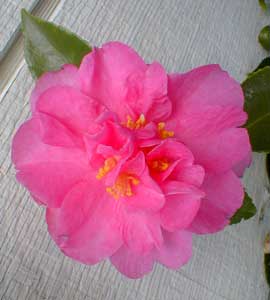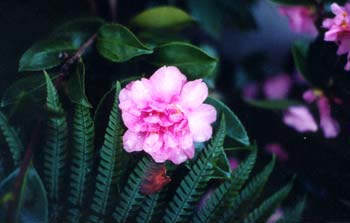
Camellia oleifera x hiemalis
'Showa-no-Sakae' aka 'Usubeni'
"The camellia flower
Fell on the tatami mat
Making a sound."
-Shirao Kaya,
1738-1791
1738-1791
'Showa-no-Sakae' is a very old hybrid camellia, long cultivated in Japan, but derived from an even older cultivar believed to have originated in China as a cross between Camellia hiemalis & C. japonica, though its origins are somewhat shrouded.
It was first cultivated in England in 1879, & was quickly in use to cross with other camellias to increase their hardiness. The variety presently baring the name 'Showa-no-Sakae' is a cross between that original SinoJapanese cultivar & C. oleifera.
The name means "Glory of Showa" or "Glory of the New Era," referring to the post-Meiji age of Reconstruction, a time of rapid modernization in Japan. But in Japan today, this camellia is actually called 'Usubeni,' alluding to its pink color.
In 2001 & 2002 it was in full ruffly bloom in November (the second portrait is from November 2002), but in 2003 it was in full bloom by October (when the first photo was snapped). It begins blooming simultaneous with our C. sasanqua 'Rosea' both of which have been espaliered on the garage wall, flanking a Climbing Hydrangea.
'Rosea' has single blooms pretty much the same dark shade of pink as 'Showa-no-Sakae' but looking quite difference since 'Showa-no-Sake' has rose-form doubles that appear amazingly fluffy. In other respects these two camellias are very similar, having medium-small leaves. This & other cultivars of C. hiemalis were formerly categorized as C. sasanqua & still often listed as such; & just like C. sasanqua it is easily adaptable to espalier.
 If not trellissed in any manner, 'Showa-no-Sakae' will remain low-growing & semi-prostrate & creep along the ground to eight feet wide but only three or four feet tall. We attached glassless vintage window frames to the garage wall in the shade corridor, & have trained our specimen upward, so it is is presently eight feet tall & will slowly over time continue higher. Though slow growing, it seems to be a little faster than the majority of camellias.
If not trellissed in any manner, 'Showa-no-Sakae' will remain low-growing & semi-prostrate & creep along the ground to eight feet wide but only three or four feet tall. We attached glassless vintage window frames to the garage wall in the shade corridor, & have trained our specimen upward, so it is is presently eight feet tall & will slowly over time continue higher. Though slow growing, it seems to be a little faster than the majority of camellias. As this evergreen shrub loves the climate in our Zone 8, it seems hardy as the dickens, but in areas either colder or hotter it can be difficult & need babying. This particular cultivar does well whether in sun or shade; ours is in semi-shade & has a lot of indirect sunlight, more shaded on the ground where its shallow root system would not like to be sun-heated. It likes a little acid fertilizer after Autumn bloom is completed.
Though this is advertised as having flowers suitable to bouquets, this is true only if you cut them before the buds are quite full open, & let them open in the vase. Once opened the petals are very apt to fall apart over the least provocation. Even on the semi-vining shrub, a good rain can beat the hell out of the flowers, though fortunately a great many more buds will open the next day.
As with our 'Rosea,' each individual flower is not all that long-lasting, but in the case of 'Showa-no-Sakae' it blooms so heavily beginning October or November & lasting clear through to February that it hardly matters that pink petals are falling throughout the months. I don't know how many other camellias there might be with such an extended bloom time, but certainly it is not the commonest feature, & I've always felt lucky to have accidentally chosen this variety despite that at the time I had no idea it would bloom such an extremely long time.